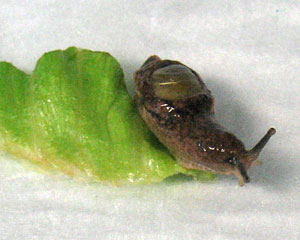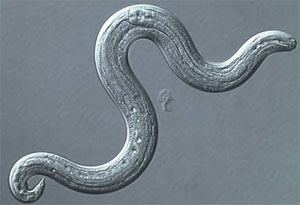Snails, Slugs, and Semi-slugs: A Parasitic Disease in Paradise
Posted April 3, 2009 by Alex daSilva

Parmarion martensi: a semi-slug commonly found in Hawaii.
CDC plays a vital role supporting state health departments, particularly with management of rare or lesser-known pathogens. Recently, CDC’s Division of Parasitic Diseases (DPD) was contacted by the Hawaii Department of Health (HI DOH) for advice regarding three cases of presumed Angiostrongylus cantonensis (AC) infection. AC, commonly called the rat lungworm, is a parasitic worm and the most common infectious cause of eosinophilic (a type of white cell) meningitis in humans worldwide.
AC has an interesting life cycle. Infected rodents carry the adult worm and pass immature worms in their feces. Mollusks (i.e., snails, slugs, or semi-slugs) become infected by ingesting immature worms in the rat feces. Humans become infected by ingesting raw or undercooked mollusks (these guys can be tiny enough to hide on a nickel; - check it out![PDF - 1 page]) infected with the worms or contaminated raw produce. Transmission might also occur through ingestion of raw or undercooked freshwater shrimps/prawns, crabs or frogs. In humans, AC causes eosinophilic meningitis, the symptoms of which can include headache, stiff neck, nausea, vomiting, low-grade fever, fatigue, and abnormal skin sensations (e.g., tingling or pain). In most cases, the symptoms disappear in weeks to months and most patients recover completely, although rare cases of blindness, paralysis, and death have been reported.

A picture from differential interference contrast microscopy showing A. cantonensis. This larva was obtained from a P. martensi slug collected in Hawaii. Infective, third-stage larvae measure 0.425 mm – 0.523 mm in length
Armed with this information, a team of scientists from USDA (HI), HI DOH and DPD began testing mollusks collected near the case-patients' homes in Hilo Puna. We used morphologic and molecular techniques to test and document infection in slug samples sent from Hawaii. HI DOH has determined that many patients live in communities outside of the municipal water/sewage system and consume home-grown produce. The DPD molecular diagnostic parasitology lab, which I lead, continues to collaborate on testing of environmental samples and the development of methods to evaluate the effectiveness of interventions to eliminate infected rodents and mollusks. In this new phase of the collaboration, a real-time PCR assay developed in-house at DPD to detect A. cantonensis is being used to analyze mollusk samples collected in Hawaii. Future efforts will involve the transferring of this real-time PCR test and other molecular methods to Hawaii so testing can be performed in-state.
Since initial contact with Hawaii, four more cases of presumed AC infection have been reported. In response, we are helping to educate the public in Hawaii on how to prevent the infection. Information has also been developed for the healthcare community in Hawaii because many physicians may not consider AC when evaluating patients with eosinophilic meningitis. AC can be prevented by avoiding the consumption of raw/undercooked snails, slugs, freshwater shrimp/prawns, crabs and frogs; by washing raw produce thoroughly prior to eating; and by wearing gloves and washing hands after handling mollusks.
Comments
No comments posted.
Disclaimer: The content of Public Health Matters expresses the opinions of its authors and does not necessarily represent the views of the Centers for Disease Control and Prevention.
- Page last reviewed: April 3, 2009
- Page last updated: April 2, 2009
- Content source: National Center for Zoonotic, Vector-Borne, and Enteric Diseases
Get email updates
To receive email updates about this page, enter your email address:
Contact Us:
- Centers for Disease Control and Prevention
1600 Clifton Rd
Atlanta, GA 30333 - 800-CDC-INFO
(800-232-4636)
TTY: (888) 232-6348
24 Hours/Every Day - cdcinfo@cdc.gov


